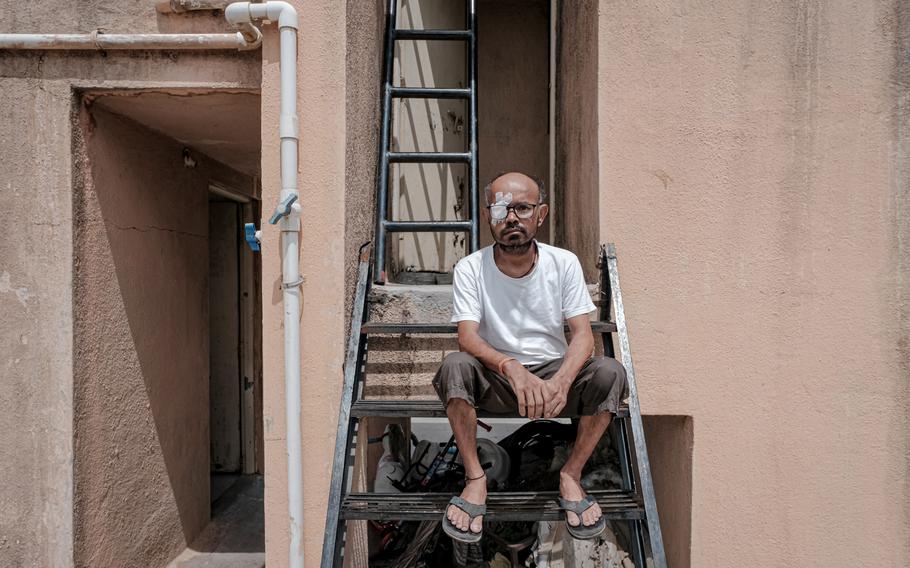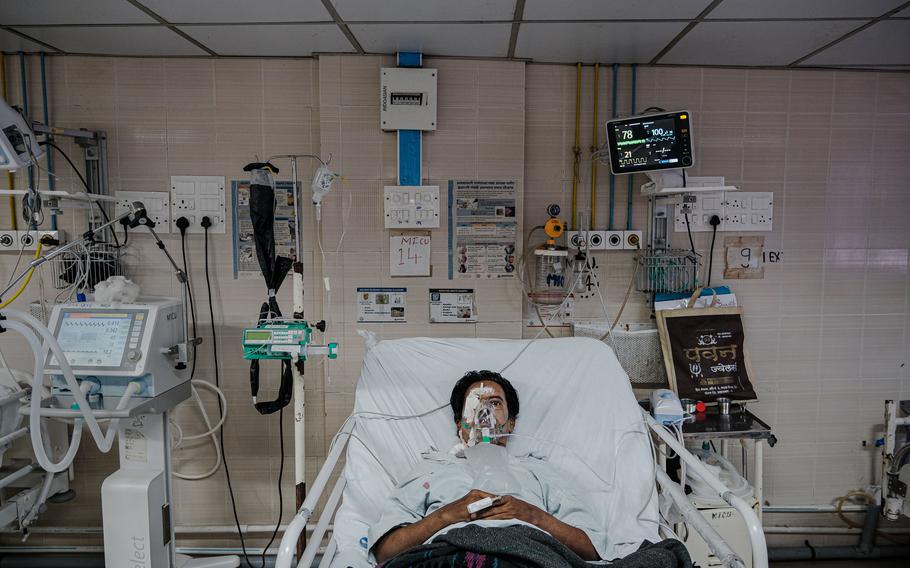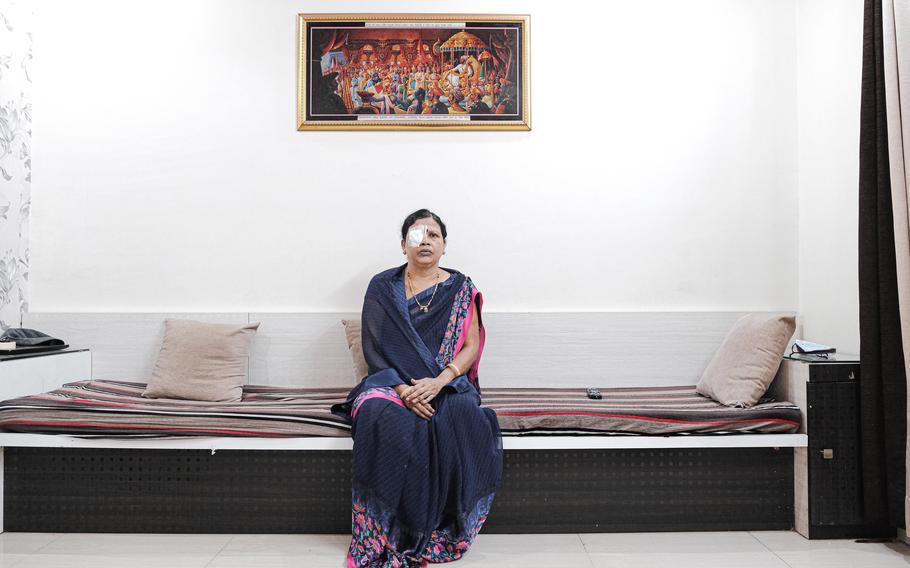
Baburao Kamble (Ronny Sen for The Washington Post)
When the coronavirus pandemic tore through India this year, its ferocity killed tens of thousands of people. But thousands of those who survived were soon back in hospitals with an ominous fungal infection called mucormycosis.
The complaints ranged from a blurring of vision to droopy eyelids or discharge from the nose. At high risk were diabetic people or those with very weak immune systems. In many cases, the only treatment is the removal of the fungus from the infected area — and that area is often the eye.
“It’s a form of flesh-eating fungus that destroys tissues as it grows,” said Akshay Nair, an oculoplastic surgeon treating mucormycosis patients in Mumbai. Before the pandemic, Nair would see 10 such patients in a year, but since January, he has treated nearly 100 affected patients. “If it involves the sinus, they have to be cleared. If it involves the eye — the eyeball, lids, muscles around the eye have to be removed, leaving behind the bare, bony socket.”
The antifungal drug used for treatment, amphotericin B, has run in short supply in India. The expensive drug has to be administered for at least three to five weeks after the surgery, increasing costs and complicating treatment efforts.
Doctors believe one reason for the spate of cases in India is the rampant use of steroids to treat COVID-19 patients. Steroids improve outcomes in serious COVID-19 patients but also make them susceptible to this infection by pushing up blood sugar levels.
Photographer Ronny Sen spent a week in Maharashtra in June with patients who made the difficult decision to have one eye removed to survive the deadly disease. The large state in western India has seen nearly 8,000 cases of the infection, and nearly 700 infected patients have died. Here are some of their stories.
Khurshida Banu
A devoted mother and caring wife, 49-year-old Khurshida Banu spent her life looking after the needs of her family. With her sons and daughter now married, she looked forward to some rest and playtime with her grandchildren. This year changed that.
In February, Banu contracted COVID-19 and suffered severe lung damage. Two weeks after she returned from the hospital, one of her eyes wouldn’t open. “It was like it didn’t exist,” said her son Ilyas. The family was shocked when the doctor told them that the eye had to be removed.
“Either take the eye out, or she may not live,” her son recounted the doctor’s advice. Banu, who has diabetes, spent 40 days at a public hospital where she received free treatment for black fungus. When she was close to her discharge date, she suffered another setback: A stroke left her right hand and leg paralyzed.
Now she is back home, but her days are punctuated by physiotherapy sessions and weekly hospital visits to change the dressing on her eye.
“Allah is kind to have saved one of my eyes,” she said. “I am happy that I am back with my family.”
Anil Baburao Wankhede

Anil Baburao Wankhede. (Ronny Sen for The Washington Post)
As a photographer, Anil Baburao Wankhede relied on two tools: his Nikon camera and his eyesight. He photographed dreamy weddings and adoring couples at engagement ceremonies. He was his family’s breadwinner, and his work helped pay for his son’s college and his daughter’s school.
In April, he recovered from COVID-19 after a brief hospitalization. But within days, he had to be readmitted. His right eye was badly swollen.
By June, Wankhede was still in the hospital, his face framed by a clump of tubes. His right eye was removed. He nearly lost his life when multiple organs began to malfunction.
Wankhede said he feels adrift. His brother had to borrow thousands of dollars to fund his treatment. The 56-year-old is unsure if he will be able to go back to his job.
“I don’t know how I will work now,” he said. “My life is devastated. There is only darkness.”
Surekha Khadche
Surekha Khadche and her family are running out of time.
In April, two weeks after she contracted COVID-19, Khadche’s right eye began to water. Then came swelling and shooting pain. Her sinus was full of black fungus, an MRI scan revealed. The family was shaken. A relative had recently lost his life to the same fungal infection before he could receive treatment.
The doctors said she needed immediate surgery because the infection would soon reach her brain. But they couldn’t operate until she tested negative for the coronavirus.
Khadche, 49, spent more than a month in the hospital, and the $12,000 bill meant the family lost much of their savings. As the family struggled to procure the amphotericin injections she needed after her hospitalization, the infection seemed to reach her second eye. Her left eyelid droops and barely opens.
She needs urgent treatment to save the other eye. She said COVID-19 was “nothing” compared with mucormycosis. “I don’t feel like living any longer,” she said.
Baburao Kamble
Baburao Kamble, 45, sells tea at construction sites in Pune. His earnings were erratic. In good months, he could make nearly $300. During lean periods, he would not make even $100.
But his income dried up when the lockdown hit last year. Then he contracted COVID-19 in February.
A week into his illness, his blood sugar level shot up. Next, the vision in his right eye began to fade.
It was black fungus, his doctor told him. The only drug that could save him was in short supply and cost more than his monthly income. Each day for a month he needed six amphotericin injections. The bills mounted to a whopping $15,000.
Kamble withdrew money prematurely from a long-term account. His wife sold her gold jewelry. A cousin took a loan on his behalf. The family moved into a relative’s home to save daily expenses.
“How will I manage this huge financial burden now?” he wondered.
Somnath Bodke
For years, Somnath Bodke taught hundreds of schoolchildren Marathi, a local language, in the state of Maharashtra. Then the pandemic shuttered schools, and in April, Bodke tested positive for COVID-19.
The signs of black fungus began 10 days after he was discharged from the hospital: His jaw began to hurt, then his eye swelled. Finally, his eyelid began to droop. A CT scan revealed the infection.
Three hospitals in the city of Nashik told him they did not have a supply of amphotericin, the antifungal drug he needed. At the main government hospital, they suggested going to Mumbai for treatment.
Since mid-May, Bodke and his brother have been living at a large public hospital in Sion, Mumbai, where his left eye was removed. His headaches have diminished since the operation, but his spirits are low.
“Life has turned dismal. I cry silently to myself,” he said. What adds to his anguish is his separation from his young daughter, who calls him every day asking when he’ll return. It will be at least another month before he will be discharged.
“Papa, we love you. Please come home soon,” his daughter said to him on a recent afternoon.
Chitra Arun Rakshe

Chitra Arun Rakshe. (Ronny Sen for The Washington Post)
In March, Chitra Arun Rakshe, a 47-year-old housewife in Pune, lost her father to a heart attack. Rakshe and her husband spent 10 days at her parents’ home for the rituals as relatives arrived to pay their respects. Some brought the virus.
When the Rakshes came back, they tested positive for the coronavirus. For 10 days in April, they were hospitalized. Her four children celebrated their parents’ return home. But the cheer was short-lived.
The irritation in her right eye got worse, and she cried in pain. Soon, her eyelid shut completely. When it was forced open, she said, she couldn’t see anything.
She begged the doctor to save her eye, but removing it was the only option. Now, her daughter Kajal, 25, changes the bandages daily. All that is left there is “skin” and an “empty hole,” said Kajal.
Rakshe’s doctor said she may be able to get an artificial eye after two months. For now, she is traumatized. “Even enemies shouldn’t be cursed with such a disease,” she said.